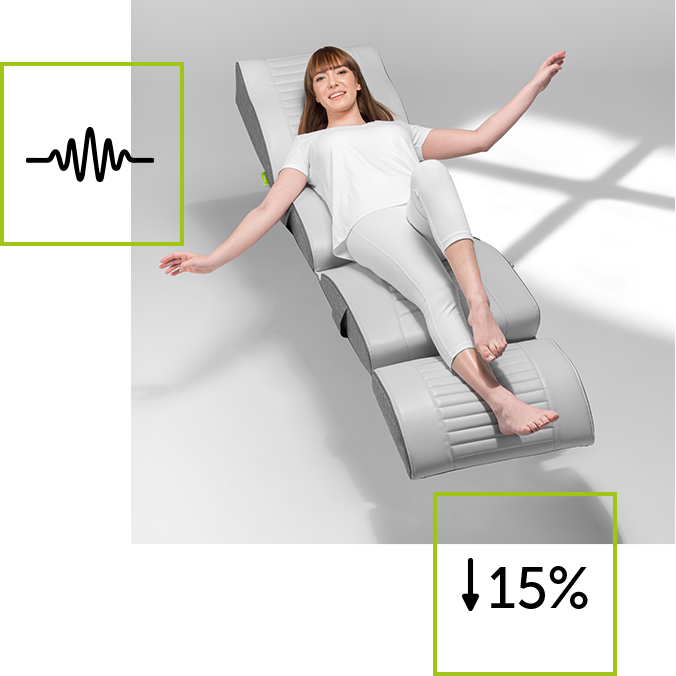Vibrotherapy – an effective method to combat neuropathic pain
Vibrotherapy is an effective support for treating neuropathic pain of various origins, as in diabetic or chemotherapy-induced neuropathy.
How does it work?
Vibrotherapy inhibits the sensation of pain, acting on many levels: it stimulates both superficial and deeply localized pain receptors, raising the pain threshold for a long time; it affects the dilation of blood vessels, regulating blood pressure; it improves the flow of lymph in tissues subjected to vibration; it relieves inflammation.


When and for whom?
Vibrotherapy is a very valuable complement to therapy directed against neuropathic pain, especially it can be a very good preparation for physical exercise, which is extremely difficult to approach while suffering pain, and which is so important in rehabilitation after serious illnesses or injuries, but also in improving the daily life of seniors or overweight people.
Effectiveness
After vibrotherapy, the average pain score of patients with diabetic neuropathy dropped from 55 to 15 after just 5 weeks, and in the following 3 weeks of therapy, patients claimed to have no pain at all. On the other hand, tingling in the extremities decreased after vibrotherapy from an average of 75 to 5 points after 5 weeks of vibrotherapy. There was also an increase in nerve conduction in both feet.

Lee K, Lee S, Song C. Whole-body vibration training improves balance, muscle strength and glycosylated hemoglobin in elderly patients with diabetic neuropathy. Tohoku J Exp Med. 2013 Dec;231(4):305-14
Benefits of vibrotherapy

No side effects

Action confirmed by scientists and practitioners

Perceptible effects from 1 treatment

Long-lasting effects through systematic use
Choose the right product
We will help you select a set of modules that suits your conditions.
Neuropathic pain – definition and characteristics
Neuropathic pain is pain caused by damage to or disease of the somatosensory part of the nervous system.” When this complex system of sensory receptors is damaged, we can say in a nutshell that the receptors transmit “false” information, such as overreacting to pain stimuli or not reacting at all. Each person has a slightly different threshold for feeling pain, but it is usually within certain norms and a given stimulus causes us similar unpleasant sensations, for example, a mosquito bite is associated with itching, putting our hand under hot water we immediately withdraw it, because we feel a burning-like pain. In people suffering from neuropathic pain, both the sensations and their intensity take a different shape. For example, a person who hits a metal table leg very hard with his shin may feel almost no pain, but a slight itching. For another, wearing a watch or bracelet will be impossible because these items cause them to feel pressure and pain. Still another person, for example, when lifting an object, may feel as if an electric current flowed through their entire hand at a moment’s notice, causing pain. Such disorders are most often defined in terms of neuropathic pain.
Causes of neuropathic pain
The cause of neuropathic pain can be nerve compression, infection, metabolic diseases, past surgery (the pain appears temporarily at the site of the scar or occurs as persistent, that is, after the wound has healed). Neuropathic pain also includes phantom pain. It is not always possible to discover the immediate source of the pain. Neuropathic pain often appears in the course of diabetes (diabetic neuropathy), as a complication after hemiplegia, accompanies cancer (sometimes it can be triggered by the treatment used: chemotherapy or radiation therapy), is present in the course of multiple sclerosis and Parkinson’s disease.
Postherpetic neuralgia
The most common complication of shingles is actually neuralgia. It is diagnosed when pain persists or recurs even though the skin lesions have healed and at least three months have passed since contracting shingles. In this case, the pain is most often burning, resembling an electric flare, stabbing, shooting, and intensifies in the evening. Postherpetic neuralgia may be accompanied by such sensory disorders as allodynia, hypersensitivity, and hypesthesia.
Diabetic neuropathy
Diabetic neuropathy (or polyneuropathy, or damage to multiple nerves) is one of the most common chronic complications of diabetes. It can produce a variety of pain symptoms usually involving the feet and hands (distal polyneuropathy). In this case, you may experience tingling, numbness, burning, cold or hot sensation in the hands or feet, pain that is worse especially at night. Sometimes in diabetic polyneuropathy there is allodynia, hyperalgesia (hypersensitivity) or, on the contrary, pain sensation is “turned off”. Diabetics can also develop another type of neuropathy, which is much more difficult to detect. We are talking about cardiovascular autonomic neuropathy. It manifests as resting tachycardia (acceleration of the heart rate) and can lead to myocardial ischemia, syncope and heart attack-like conditions.
Treatment of neuropathic pain
If the cause of neuropathic pain is known, the first step is to cure the disease in question, or at least stabilize it (for example, in the case of diabetes). This type of pain most often does not respond to analgesics and anti-inflammatory drugs (they are not very effective). However, at present – according to the recommendations of the Polish Pain Research Society and the Neurological Society - the mainstay of treatment for neuropathic pain is pharmacology. Antidepressants, antiepileptic drugs, topically administered lidocaine, and potent opioid analgesics (such as tramadol) are used for this purpose. This is a group of so-called first-choice drugs, and the effectiveness of individual drugs should be controlled both individually and in combinations. Only after such trials is it recommended to move to a group of second- and then third-choice drugs. Such a prospect of treatment does not sound very optimistic, hence doctors point to the necessity of including non-pharmacological treatment, and to this end numerous studies are being conducted, including the use of vibrotherapy, the results of which are very promising.





